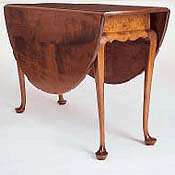
QUESTION: I have a three-piece set of furniture that belonged to my grandparents and perhaps to their parents, and I'm trying to identify what it is. Can you tell me if you think it might be Eastlake and if so, what can you tell me about this furniture style?
ANSWER: What you have is an Eastlake parlor set, dating from around 1880. But it wasn’t designed by Charles Locke Eastlake. Instead, he only suggested designs in his book Hints on Household Taste in Furniture, Upholstery and Other Details. More than any other person, he was responsible for introducing the principles of the English design reform movement to America.
Eastlake considered simplicity the key to beauty. He thought the objects in people's homes should be attractive and well made by workers who took pride in their hand work or machine work. His influence led to a broad demand for relatively simple, clean-lined "art furniture" between 1870 and 1890.
Written to instruct the average housewife in the principles of tasteful home decoration, Eastlake’s book achieved immediate popularity. Though Eastlake included some of his own sketches among the illustrations of well-designed furniture chosen for his book, he was primarily a critic of taste, not a furniture designer. The furniture illustrated in it had ornamental features including shallow carving, marquetry, incised or pierced geometric designs, rows of turned spindles, chamfered edges, brass strap hinges, bail handles, and keyhole hardware inspired by Gothic forms. Every decorative device, according to Eastlake, also had to fulfill a useful function.
He especially disdained the "shaped" forms of Rococo Revival. He considered the curved forms of this Victorian style rickety and constructively weak. To relieve the simplicity of rectilinear forms, Eastlake advised using turned legs or spindle supports.
For those who wished more richness in their furniture, he suggested restrained, conventionalized carving, inlay, and sometimes even veneer. Eastlake believed ornament should be stylized rather than naturalistic.
His book further suggested that furniture be made of solid, strongly grained woods such as mahogany, walnut, or oak. Most Eastlake-style furniture found today is usually made of the latter.He preferred oil-rubbed finishes to "French-polished" ones, and disliked the shiny look of varnish.
To the modern eye, Eastlake-style furniture, with its intricate marquetry, gilded incised designs, spindled galleries, inset tiles, richly grained woods, and decorative turned elements, hardly seems “simple.” But in contrast to the heavily carved furniture of earlier Victorian decades, embellished with naturalistic roses and bunches of grapes imposed on the elaborate Rococo shapes now regarded as the embodiment of Victorian design, Eastlake-inspired furniture was remarkably functional and clean-lined.
Eastlake-style furniture often featured tables and chests with marble tops, some the traditional white, others in rich Italian pinks and browns. Tables and chairs had aprons and legs incised with horizontal or vertical lines called reeding and camfered corners. Round legs on chairs also featured ring-like annulets. And acanthus leaf designs could be found incised into even the least expensive pieces.
Unfortunately, while Eastlake-style furniture may have looked refined, most chairs and sofas weren’t very comfortable and were meant to be used in formal parlors for guests only.




